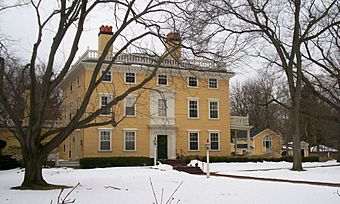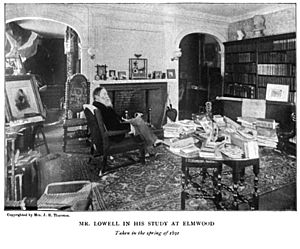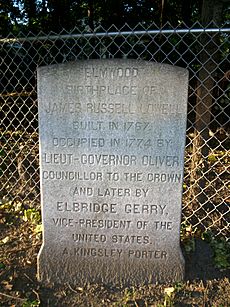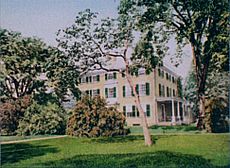Elmwood (Cambridge, Massachusetts) facts for kids
|
Elmwood
|
|

Elmwood, December 2008
|
|
| Location | 33 Elmwood Avenue, Cambridge, Massachusetts |
|---|---|
| Built | 1767 |
| Architect | Thomas Oliver |
| Architectural style | Georgian |
| NRHP reference No. | 66000364 |
Quick facts for kids Significant dates |
|
| Added to NRHP | October 15, 1966 |
| Designated NHLD | December 29, 1962 |
Elmwood, also known as the Oliver-Gerry-Lowell House, is a special historic home in Cambridge, Massachusetts. It's famous because several important people lived there. These include Thomas Oliver, who was a royal governor before the American Revolution. Also, Elbridge Gerry, who signed the US Declaration of Independence and became Vice President of the United States. He even inspired the word "gerrymandering"! Later, James Russell Lowell, a well-known American writer and poet, called Elmwood home.
The house was built around 1767 in the Georgian style. It was first owned by Lieutenant Governor Thomas Oliver. When the American Revolutionary War began, Oliver, who supported the British, left the house. The state of Massachusetts then took it over.
Later, Elbridge Gerry bought Elmwood. He lived there with his family until he passed away in 1814. After him, the Lowell family bought the house. James Russell Lowell was born there and lived most of his life in Elmwood. Today, Harvard University owns Elmwood, and it's where the university's president lives.
The house still looks much like it did in the Georgian period. While the inside was decorated in a Victorian style by the Lowells, Harvard later changed it back to its original Georgian look. You can't visit the house inside, but the area around it, including Lowell Park, is a National Historic Landmark District.
Contents
Elmwood's Exciting History
Early Days with Thomas Oliver
The Elmwood house was built around 1767 for Thomas Oliver. He became the Lieutenant-Governor of Massachusetts in 1774. Oliver was a very wealthy man. His family owned large plantations in the Caribbean, where many people worked. Oliver and his wife, Elizabeth Vassall, also had 11 people working at Elmwood.
The Oliver-Vassall estate was huge, covering about 100 acres (40 hectares). It had beautiful fields and great views of the Charles River. The land stretched from Fresh Pond all the way to what is now the Boston neighborhood of Brighton.
The American Revolution and Elbridge Gerry
In September 1774, British soldiers took gunpowder from a storage building in nearby Somerville. This event, called the Powder Alarm, made many local militias gather. Thomas Oliver helped calm the crowd by talking to the British governor. However, people followed him home and made him resign from his job. Soon after, Oliver and his family left for Boston.
During the siege of Boston in 1775, American troops used Elmwood. Benedict Arnold, a famous general, stayed there for a time. After the Battle of Bunker Hill, the house became a hospital. When the British left Boston in 1776, the Olivers, like many other British supporters, went with them to Nova Scotia. Thomas Oliver later moved to England and died there in 1815.
The Massachusetts government took Oliver's property during the American Revolutionary War. In 1787, Elbridge Gerry bought the estate. It became his family home. Gerry was a very important person. He signed the US Declaration of Independence and later became Governor of Massachusetts. He also served as Vice President of the United States.
Gerry is famous for the term "gerrymandering." This word describes how political districts are sometimes shaped in strange ways to help one political party win elections. He took his oath of office as Vice President right there in Elmwood in 1813. Gerry passed away in 1814.
The Lowell Family's Time at Elmwood

In 1818, Charles Russell Lowell, Sr. bought ten acres of the estate, including the house. His son, James Russell Lowell, was born in Elmwood on February 22, 1819. James Russell Lowell grew up to be a famous writer, poet, and diplomat.
Lowell faced many sad times in his life, including losing his mother and young daughter. To help with money, he sold off parts of the Elmwood land. Eventually, only two and a half acres remained. Even with these challenges, he loved Elmwood. He once wrote to a friend, "I am back again to the place I love best."
Lowell named the house "Elmwood" because of the elm trees around it. He even mentioned the house in some of his poems. His friend, the poet Henry Wadsworth Longfellow, also wrote a poem about the house called "The Herons of Elmwood."
Many interesting people visited or lived at Elmwood during Lowell's time. The writer Thomas Bailey Aldrich rented the house for two years. He loved living there, saying, "Sunrise and sunset, rainstorms and snowstorms, have quite a new meaning to us here." Later, the famous violinist Ole Bull and the Norwegian writer Bjørnstjerne Bjørnson also stayed at Elmwood. James Russell Lowell lived in the house until he passed away on August 12, 1891.
Elmwood Today: A Harvard Home
After James Russell Lowell's death, his daughter and her children used Elmwood for a while. In 1920, Arthur Kingsley Porter, a Harvard professor, bought the house. He used it as his home and even taught some classes there. When he passed away in 1933, he left Elmwood to Harvard University.
After some big renovations, Elmwood became the official home of Harvard's presidents in 1971. It still holds some of James Russell Lowell's old library books.
The Harvard-owned property and the nearby Lowell Park are a National Historic Landmark District. Lowell Park was created in 1899 to honor James Russell Lowell. It's a beautiful park that was once part of the original Elmwood estate.
Elmwood's Classic Look
Elmwood is a large, square house with a classic Georgian style. It has a wooden exterior and two chimneys. Inside, each floor has two rooms on either side of a central hallway with a staircase. The windows have fancy decorations, and a railing surrounds the roof. The front entrance has columns and a triangular shape above a large window.
Over the years, the house has had a few changes. The Lowell family added some modern parts and a library to the west side. They also added a porch and a terrace. When Harvard took over, they changed the inside back to its original 18th-century Georgian style.
See also





